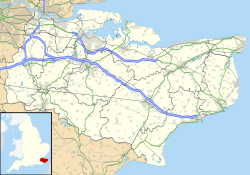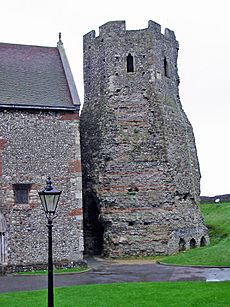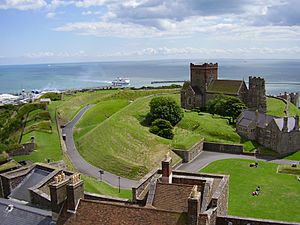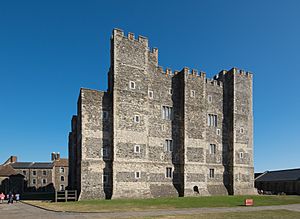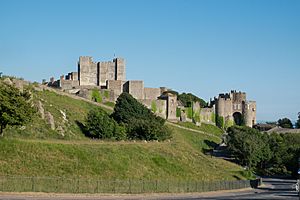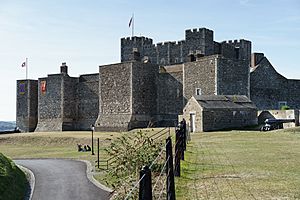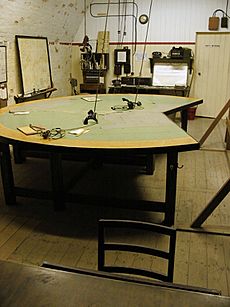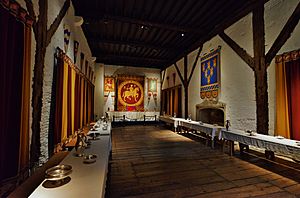Dover Castle facts for kids
Quick facts for kids Dover Castle |
|
|---|---|
| Dover, Kent, England | |
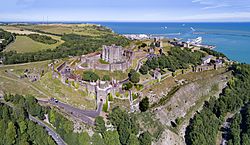
Aerial panorama of the castle
|
|
| Coordinates | 51°07′47″N 1°19′17″E / 51.1297°N 1.3214°E |
| Type | Norman castle |
| Site information | |
| Owner | English Heritage |
| Condition | Intact |
| Site history | |
| Built | 12th century |
| Built by | Henry II |
| Events | First Barons' War |
Dover Castle is a huge medieval castle located in Dover, Kent, England. It was built in the 11th century and is often called the "Key to England." This is because it has been super important for defending England throughout history. Some people even say it's the biggest castle in England, though Windsor Castle also claims that title!
Contents
A Look Back in Time
Ancient Times
People might have built earth walls here even before the Romans arrived in AD 43. This idea comes from the unusual shape of the earthworks, which don't quite match the medieval castle. We have found signs of people living here during the Iron Age, but we're not sure if it was part of a hillfort.
Roman Era
The castle grounds also have one of Dover's two Roman lighthouses. It's one of only three Roman lighthouses still standing in the world! It's also the tallest and most complete Roman building in England. Many believe it's Britain's oldest standing building.
This lighthouse was built in the early 2nd century. It has five levels and eight sides, made from layers of tufa, Kentish ragstone, and red bricks. It survived because it was turned into a belfry (bell tower) around the year 1000. A new top section was added around 1430, and it was partly fixed up in 1913–1915.
Across Dover, on the Western Heights, you can find the small remains of the other Roman lighthouse. It's known as the Bredenstone.
A Roman lighthouse called the Tour d'Ordre was built across the English Channel in Boulogne-sur-Mer. It was built around 39 AD by Emperor Caligula, possibly to prepare for invading Britain. This lighthouse was visible from Dover. Sadly, it fell into the sea in 1644 due to coastal erosion. Old drawings of its height might show how the Dover Roman lighthouse once looked.
Saxon and Early Norman Times
After the Battle of Hastings in October 1066, William the Conqueror and his army marched to Westminster Abbey for his coronation. They took a long way around, going through Romney, Dover, and Canterbury. Since the Cinque Ports were formed in 1050, Dover has always been a very important member. This might be why William paid so much attention to it.
A writer named William of Poitiers said that William marched to Dover, which was thought to be very strong. The English were scared and decided to give up. But some Normans, wanting money, set the castle on fire! William then paid to fix it and spent eight days adding new defenses. The first castle was made entirely of clay, but it collapsed. The clay was then used for the floors of many rooms.
In 1088, eight knights were chosen to guard Dover Castle. They were William d'Albrincis, Fulberl de Dover, William d'Arsic, Geoffrey Peverell, William Maminot, Robert du Port, Hugh Crevecoeur, and Adam Fitzwilliam.
Henry II to Early Modern Times
Dover Castle started to look like it does today during the time of Henry II. The inner and outer walls, and the huge main tower (keep), were built then. Maurice the Engineer was in charge of building the keep. From 1179 to 1188, the King spent over £6,500 on the castle. This was a huge amount of money, especially since his yearly income was only about £10,000!
In 1216, during the First Barons' War, some rebel barons invited Louis VIII of France to become king of England. He managed to break through some of the castle walls, but he couldn't capture the castle. The weak north gate that was broken during the attack was turned into an underground defense area. New gates were also built into the outer walls on the west (Fitzwilliam's Gate) and east (Constable's Gate) sides. During the attack, the English defenders dug tunnels outwards and surprised the French.
Later, a windmill was built on Tower 22, which became known as the Mill Tower. By the Tudor age, cannons and gunpowder had changed how wars were fought. King Henry VIII improved the castle's defenses. He even visited in person and added the Moat Bulwark.
During the English Civil War, the castle was held by the King's supporters. But in 1642, supporters of the Parliamentarians took it without a fight! A local merchant named Richard Dawkes and ten men climbed the cliffs. They attacked the gatekeeper's lodge, got the keys, and entered the castle before the guards could react.
Dover Castle was also a key spot for a big survey between England and France from 1784 to 1790. This survey used math (trigonometry) to connect the Royal Greenwich Observatory with the Paris Observatory. General William Roy led this important work.
Napoleonic Era
Huge changes were made to the castle in the late 1700s during the Napoleonic Wars. William Twiss, a top engineer, worked to improve Dover's defenses. He added large new gun positions on the eastern side, like the Horseshoe and Hudson's Bastions. He also built the Constable's Bastion for extra protection on the west.
Twiss also made the Spur, at the north end of the castle, stronger. He added a raised gun platform there. He even took the roof off the main tower and replaced it with strong brick arches so heavy cannons could be placed on top. Twiss also built Canon's Gateway to connect the castle's defenses with the town's.
Since Dover became a military town, there was a need for places for soldiers to live and store their gear. Twiss and the Royal Engineers decided to build tunnels for barracks about 15 meters below the cliff top. The first soldiers moved in during 1803. The windmill on the Mill Tower was taken down during the Anglo-American War. It was said that selling the materials from the mill didn't even cover the cost of taking it down!
After the Napoleonic Wars, some tunnels were used by the Coast Blockade Service to fight smuggling. But this didn't last long, and the tunnels were left empty for over 100 years.
Second World War
When World War II started in 1939, the tunnels were first used as an air-raid shelter. Later, they became a military command center and an underground hospital. In May 1940, Admiral Sir Bertram Ramsay led the famous evacuation of French and British soldiers from Dunkirk, called Operation Dynamo. He directed this huge effort from his headquarters in these cliff tunnels.
A military telephone exchange was put in the tunnels in 1941. The switchboards were always busy. A new tunnel had to be dug next to it just to hold the batteries and chargers needed to keep them working. There's a statue of Admiral Sir Bertram Ramsay outside the tunnels today. It honors his work during the Dunkirk evacuation and his efforts to protect Dover during the war.
After the War
After the war, the tunnels were planned to be a shelter for the government in case of a nuclear attack. But this plan was dropped for several reasons. One reason was that the chalk cliffs wouldn't protect much from radiation. Also, the tunnels were not in good shape and were hard to use.
The tunnel levels have names: A - Annexe, B - Bastion, C - Casemate, D - Dumpy, and E - Esplanade. You can visit the Annexe and Casemate levels. The Bastion level is "lost," but people are still trying to find and open it. Dumpy (used as a government shelter during the Cold War) and Esplanade (used as an air raid shelter in WWII) are closed.
Between 2007 and 2009, English Heritage spent £2.45 million to make the castle's inside look like it did in the past. In 2019, over 368,000 people visited Dover Castle. The Queen's & Princess of Wales's Royal Regiment Regimental Museum is also located inside the castle.
Dover Castle is a Scheduled Monument. This means it's a "nationally important" historic building and archaeological site that is protected. It's also a Grade I listed building, recognized as a very important structure worldwide. The Lord Warden of the Cinque Ports is officially in charge of the castle, also known as the Constable of Dover Castle. The Deputy Constable lives in Constable's Gate.
Churches and Chapels
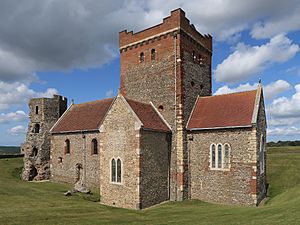
There are two special religious places inside the castle grounds:
- Royal chapel - This is inside the main tower and is dedicated to St Thomas Becket.
- St Mary in Castro - This is an old Saxon church that was rebuilt in the Victorian era.
Filming Location
Dover Castle has been used as a location for many TV shows and movies. Some examples include the Doctor Who episode The Mind of Evil, Wolf Hall, The Hollow Crown, and The Amazing Race 31.
Images for kids
See also
 In Spanish: Castillo de Dover para niños
In Spanish: Castillo de Dover para niños


